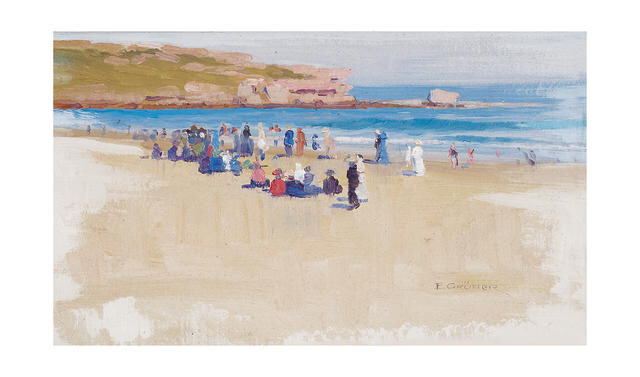Elioth Gruner, (1882-1939)
Bondi Beach, 1911
Bondi Beach, 1911
signed lower right: 'E GRUNER'
oil on board
15.0 x 25.5cm (5 7/8 x 10 1/16in).
PROVENANCE
Fine Art Society, Sydney
Collection of Howard Hinton, Sydney, acquired from the above for 6 gns
Collection of William Grant Buckle, Sydney
Leonard Joel, Australian, New Zealand, British and European, Historical and Contemporary Paintings, Watercolours, Drawings and Sculpture, Melbourne, 7 November 1984, lot 1317
Lauraine Diggins Gallery, Melbourne (label attached verso)
Private collection, Brisbane
EXHIBITED
probably Loan Exhibitions of the Works of Elioth Gruner, National Art Gallery
of New South Wales, Sydney, 21 December 1932 ? 21 February 1933, cat. 58
In his 1983 monograph on the artist, then Art Gallery of New South Wales Australian art curator Barry Pearce noted that 'There are basically two phases of beach scenes by Gruner: those painted c.1912-14; and then c.1917-20. Most of the panels of this genres between 1912 and 1920 display flat open spaces with delicate placement of ribbon-like figures, revealing the abiding influence of Whistler and Japonisme. When Gruner made money he in fact bought Japanese prints and objets d'art, and was well aware of decorative fashions (he had been after all, a draper's assistant and a window-dresser)...
He may have also been aware of Whistler's little beach 'pochades' through published illustrations. Gruner's own beach and coast scenes were an important part of his early recognition, and reviewers enthusiastically compared them with Charles Conder. Certainly the work of Conder was available to Gruner at this time: Departure of the S.S. Orient was hanging in the Art Gallery of New South Wales, and good examples were in Sydney private collections, including those of Julian Ashton, D.H. Souter and G.S. Mann, the Director of the Gallery. The Gallery has a 1913 beach scene painted by Harley Griffiths who was at the time working and experimenting with oil painting techniques Gruner.
Above all, however, Gruner's beach panels were a product of his love of and physical involvement with the subject. His first beach paintings coincide with about the time he moved to Bondi from North Sydney. He was shortly to be known as an enthusiastic body-sufer although, with his frail build, not very proficient at it.'
Barry Pearce, Elioth Gruner, 1882-1939, Art Gallery of New South Wales, Sydney, 1983, p. 30
We gratefully acknowledge the kind assistance of Steven Miller in cataloguing this work.
View it on
Estimate
Time, Location
Auction House
Bondi Beach, 1911
Bondi Beach, 1911
signed lower right: 'E GRUNER'
oil on board
15.0 x 25.5cm (5 7/8 x 10 1/16in).
PROVENANCE
Fine Art Society, Sydney
Collection of Howard Hinton, Sydney, acquired from the above for 6 gns
Collection of William Grant Buckle, Sydney
Leonard Joel, Australian, New Zealand, British and European, Historical and Contemporary Paintings, Watercolours, Drawings and Sculpture, Melbourne, 7 November 1984, lot 1317
Lauraine Diggins Gallery, Melbourne (label attached verso)
Private collection, Brisbane
EXHIBITED
probably Loan Exhibitions of the Works of Elioth Gruner, National Art Gallery
of New South Wales, Sydney, 21 December 1932 ? 21 February 1933, cat. 58
In his 1983 monograph on the artist, then Art Gallery of New South Wales Australian art curator Barry Pearce noted that 'There are basically two phases of beach scenes by Gruner: those painted c.1912-14; and then c.1917-20. Most of the panels of this genres between 1912 and 1920 display flat open spaces with delicate placement of ribbon-like figures, revealing the abiding influence of Whistler and Japonisme. When Gruner made money he in fact bought Japanese prints and objets d'art, and was well aware of decorative fashions (he had been after all, a draper's assistant and a window-dresser)...
He may have also been aware of Whistler's little beach 'pochades' through published illustrations. Gruner's own beach and coast scenes were an important part of his early recognition, and reviewers enthusiastically compared them with Charles Conder. Certainly the work of Conder was available to Gruner at this time: Departure of the S.S. Orient was hanging in the Art Gallery of New South Wales, and good examples were in Sydney private collections, including those of Julian Ashton, D.H. Souter and G.S. Mann, the Director of the Gallery. The Gallery has a 1913 beach scene painted by Harley Griffiths who was at the time working and experimenting with oil painting techniques Gruner.
Above all, however, Gruner's beach panels were a product of his love of and physical involvement with the subject. His first beach paintings coincide with about the time he moved to Bondi from North Sydney. He was shortly to be known as an enthusiastic body-sufer although, with his frail build, not very proficient at it.'
Barry Pearce, Elioth Gruner, 1882-1939, Art Gallery of New South Wales, Sydney, 1983, p. 30
We gratefully acknowledge the kind assistance of Steven Miller in cataloguing this work.



